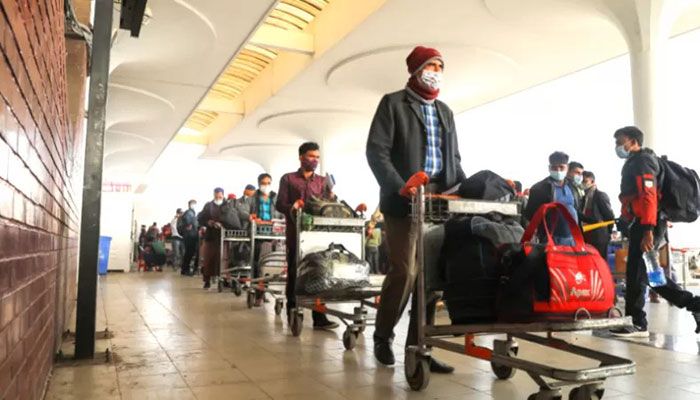
Desk Report
Publish: 23 Aug 2022, 02:34 pm

A file photo shows Bangladeshi migrants waiting in a queue to board their flight at Hazrat Shahjalal International Airport in Dhaka || Photo: Collected
The government has chalked out a plan to send 810,000 Bangladeshi workers abroad in the current fiscal year (2022-23).
They have also decided to provide skills development training to 520k workers in the current fiscal year (2022-23).
Besides, training up more workers for meeting the demands of the overseas job market, it expects to start the operation of some 100 technical trainer centres in different parts of the country.
According to an official document, it is important to provide necessary training to workers for their skills development and ensure their better jobs abroad.
From the last fiscal year (2021-22), all the training programmes of technical training institutes and institutes of marine technology are conducted under the National, Technical and Vocational Qualification Framework (NTVQF).
Recognition of prior learning (RPL) activities have been taken up for effective use of the learning by migrant workers abroad to increase their earnings in the overseas labour market.
Apart from this, foreign language teaching courses are going on in the 43 Teachers Training Colleges (TTCs).
In addition, for bringing discipline to the immigration system three new online systems titled- ‘Employee Connectivity Reporting System’, ‘Online Grievance Management System’, and ‘Recruiting Agencies Information Management system (RAIMS)’ have been introduced, said the document.
The government has taken up a range of initiatives for the welfare of both expatriate workers and workers returning from abroad.
The discipline in the immigration system has been ensured by monitoring the activities of the recruiting agencies on regular basis.
The document mentioned that this sector has been completely digitalised through different programmes like- creating a professional database for employee recruitment; scrutinizing visa forms through mobile apps; a separate portal for receiving grievance petitions and automation of the activities of the ‘Bureau of Manpower, Employment and Training’ (BMET).
A number of activities are going on for the purpose of re-integration of migrant workers who have returned home and providing soft investment loans for their self-employment; providing scholarships to the meritorious children of the expatriates and providing medical assistance to the disabled expatriate workers on their return.
A plan of action for establishing technical training institutes at every Upazila in phases has been taken up for inspiring the marginalised communities across the country.
The document said that in 2020-2021 FY the growth of remittance stood at 36.10 per cent. However, since the very beginning of fiscal 2021-2022, the income from remittances slightly decreased.
With a view to encouraging remittance through legal channels, the government has raised the rate of incentives by 0.5 per cent to 2.5 per cent from January 2022.
The government has withdrawn the mandatory provisions for submission of earning documents of the remitters in the case of availing cash incentives against remittances exceeding the amount of US$ 5,000.
It is expected that a satisfactory growth of remittance will be back on track soon, said the document.
In 2019, $18.32 billion was remitted to Bangladesh, the third-highest recipient of remittance in South Asia.
Over 10 million Bangladeshis are living and working abroad, mainly in the Middle East. They are the second largest contributor to the country’s foreign remittances after the garment sector. Last year alone, they sent over $22 billion back home, according to Bureau of Manpower Employment and Training data.
According to the BMET, in 2019 alone, over 700,000 migrant workers left the country in search of employment abroad and over 73 per cent of remittances were sent from Gulf Cooperation Council countries.
Remittance inflows to Bangladesh directly impact socio-economic development and act as a lifeline to vulnerable communities.
There should be an investment in education and skills upgrade so that lower-skilled migrant workers can earn more and break the cycle of debt, the International Organisation of Migration suggests.
Subscribe Shampratik Deshkal Youtube Channel
© 2024 Shampratik Deshkal All Rights Reserved. Design & Developed By Root Soft Bangladesh